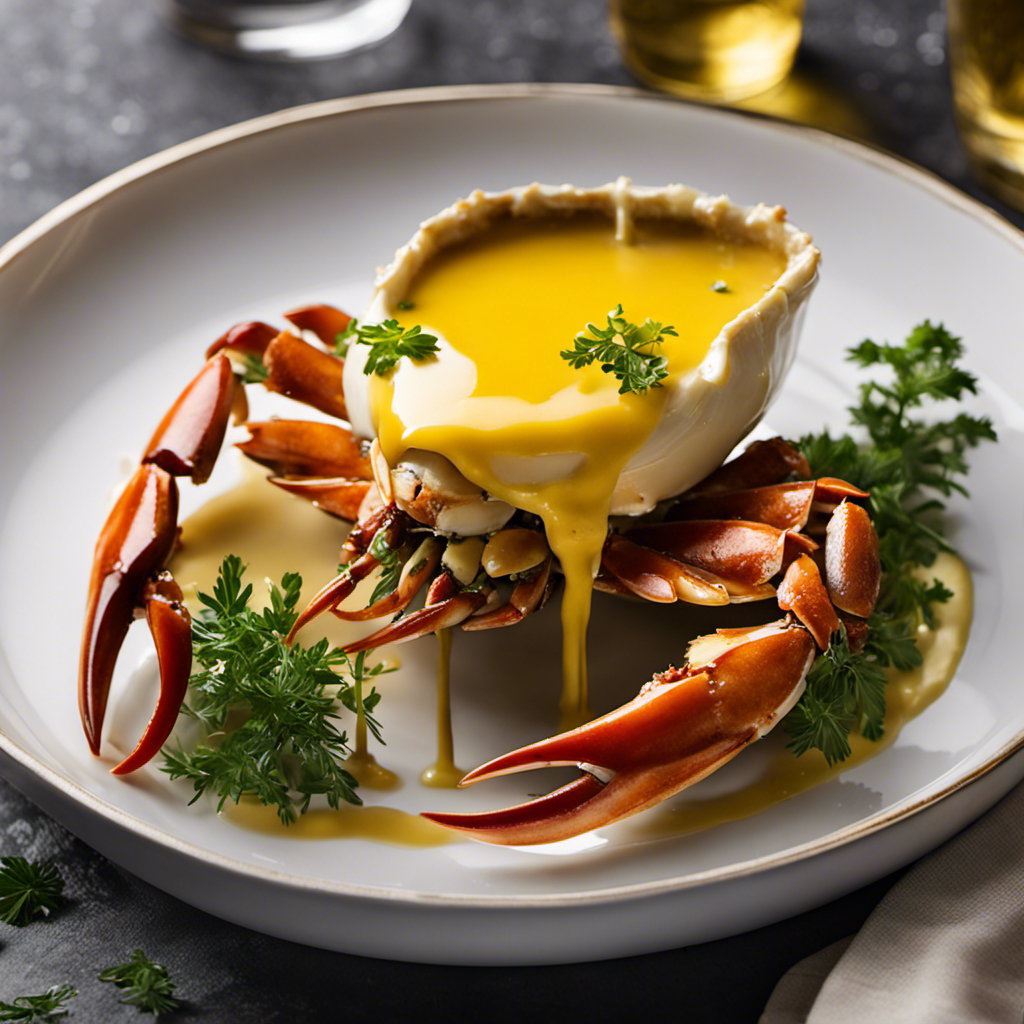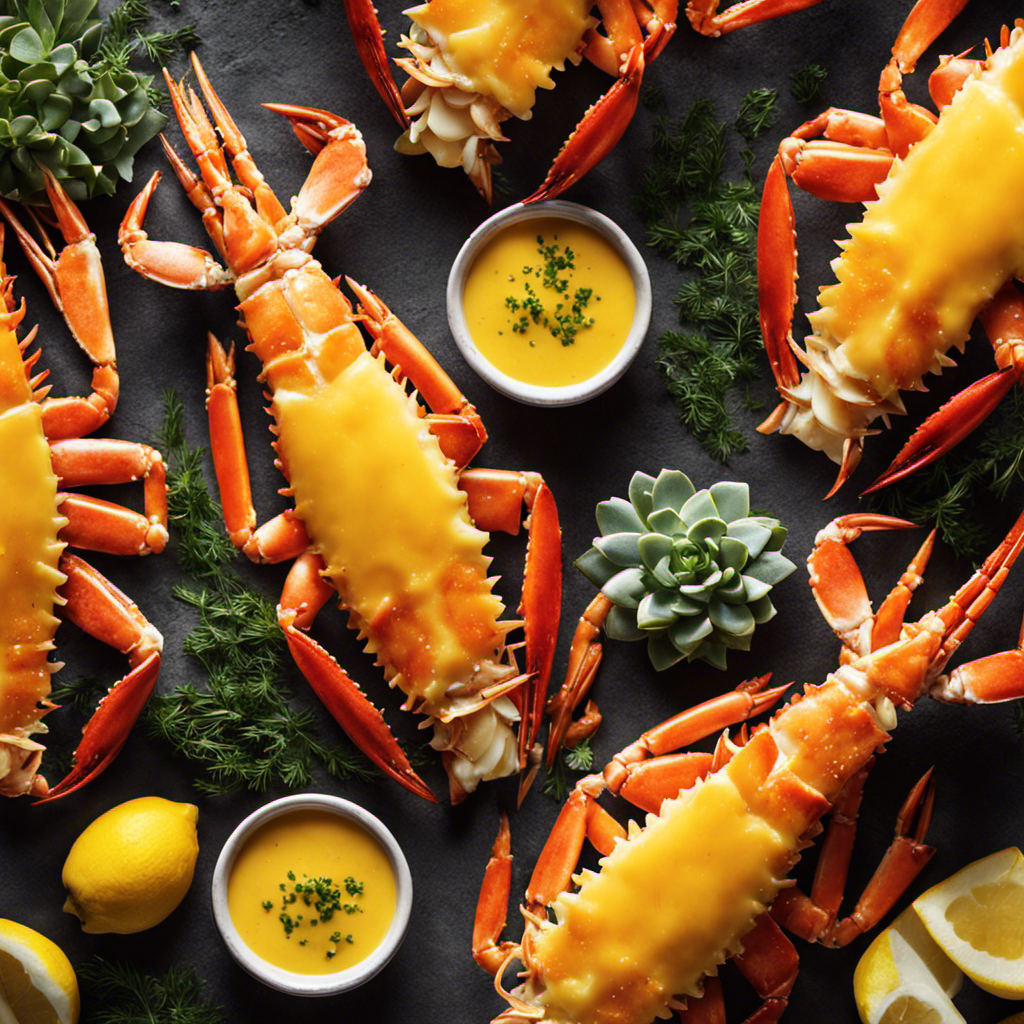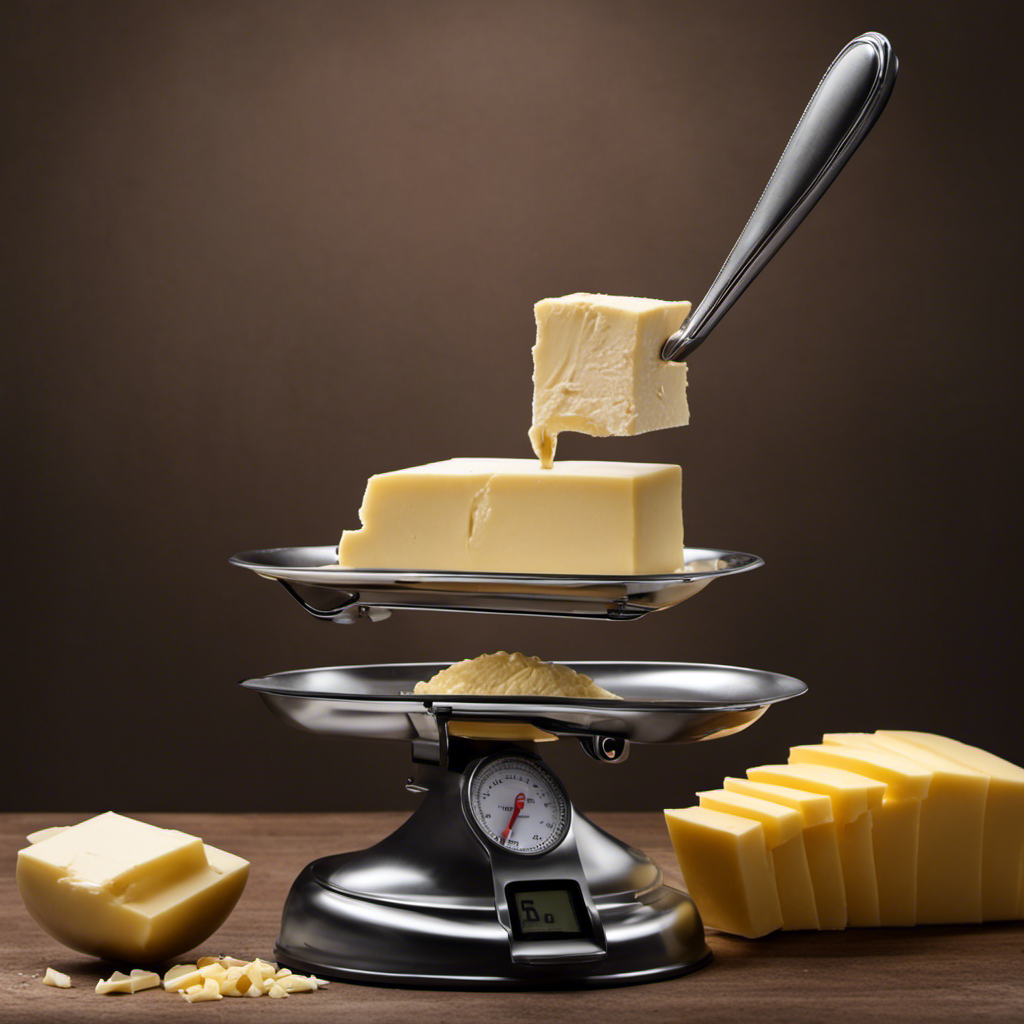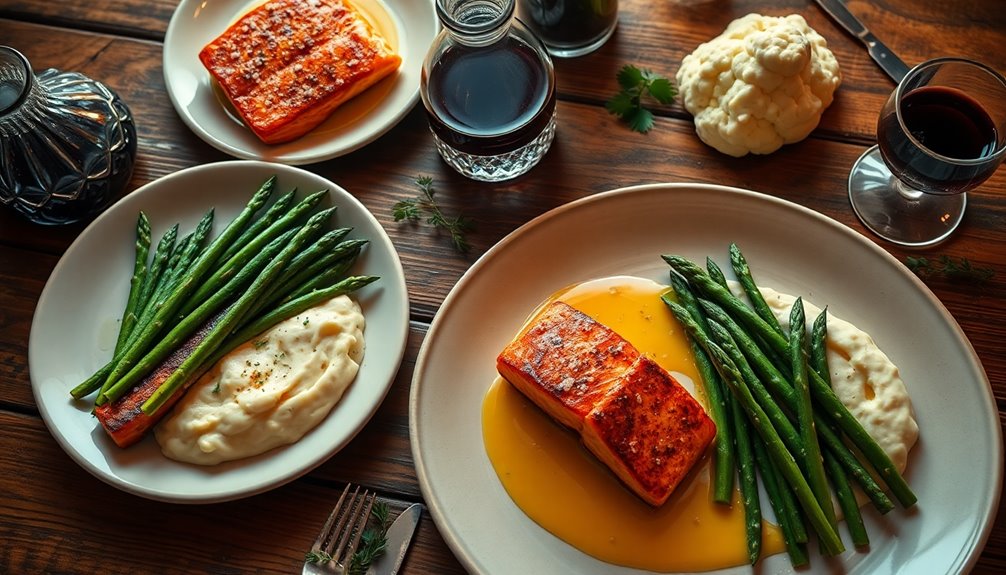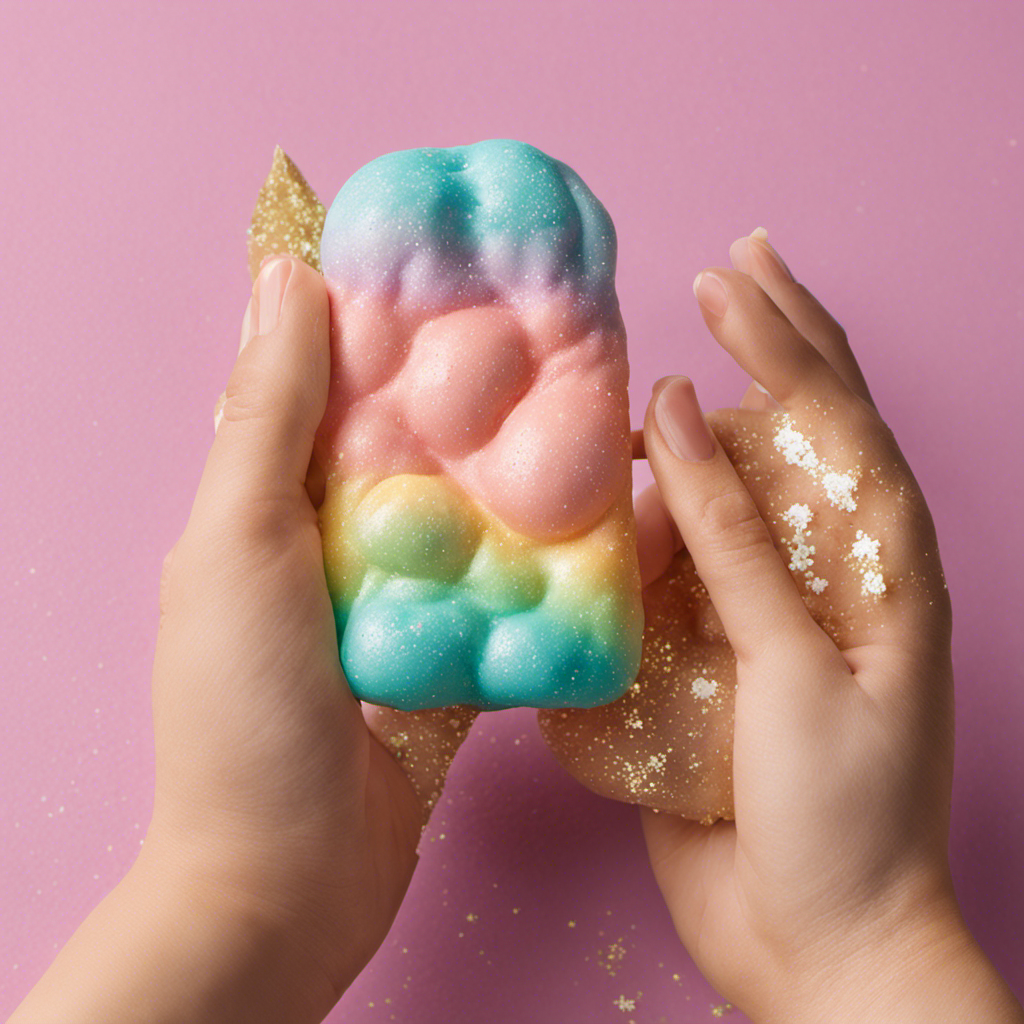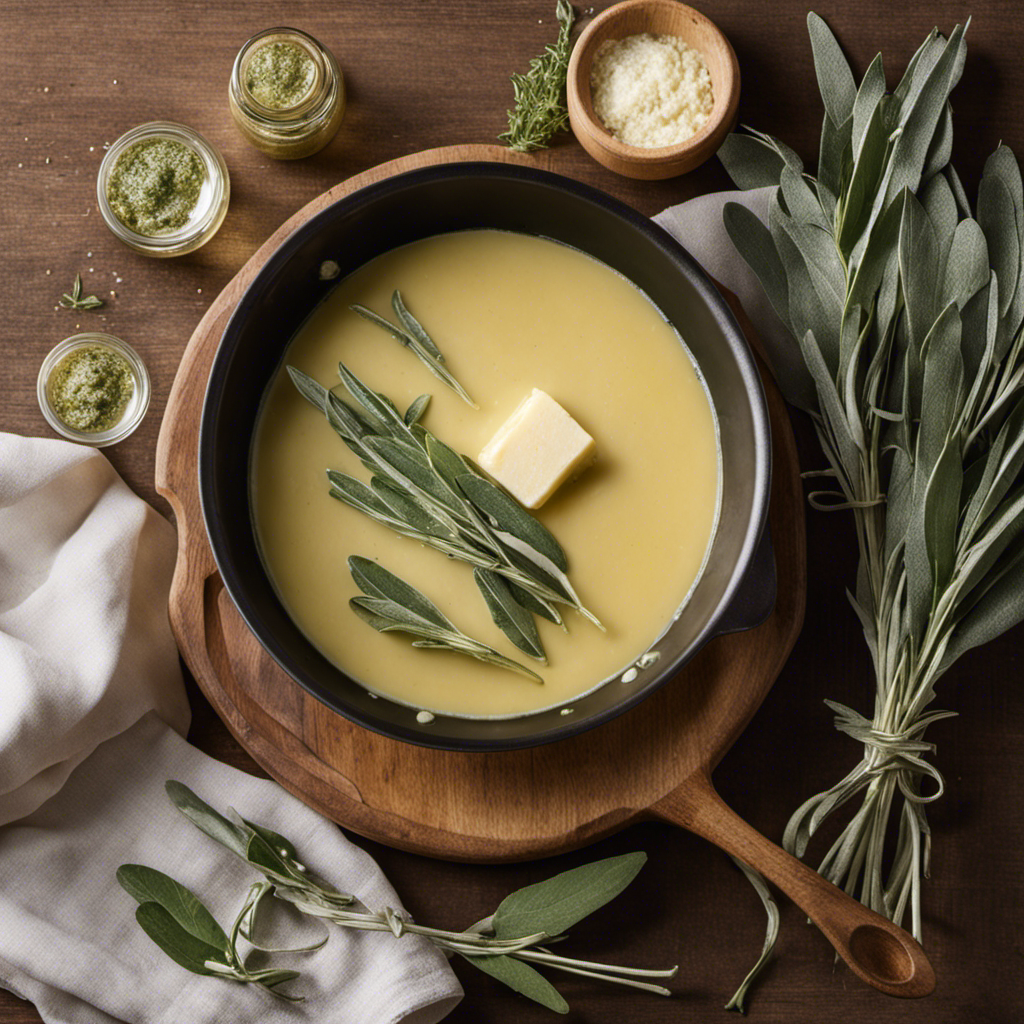I really enjoy treating myself to a delicious crab feast, especially when it comes with a creamy and savory butter sauce. In this article, I will walk you through the steps of making a tasty butter sauce that enhances the natural sweetness of crab meat.
We’ll start by gathering the necessary ingredients and then move on to preparing the crab. From there, we’ll dive into making the base for the sauce, adding the butter, and seasoning it to perfection.
Get ready to savor every bite of this delectable butter sauce with your favorite crab dish.
Key Takeaways
- Butter sauce is made with ingredients such as butter, garlic, lemon juice, and parsley.
- There are different variations of butter sauce that can be made.
- Cleaning and preparing the crab involves removing the shell, gills, apron, and innards to access the meat.
- The cooking time required for crab can vary depending on the method used, such as steaming, boiling, grilling, or baking.
Ingredients for Butter Sauce
You’ll need a few key ingredients for the butter sauce, including butter, garlic, lemon juice, and parsley.
Butter sauce is a versatile condiment that can be used in various dishes, including crab. There are different variations of butter sauce, each with its own unique flavor profile.
One popular variation is garlic butter sauce, which adds a rich and savory taste to the crab. Another variation is lemon butter sauce, which adds a tangy and refreshing twist.
To achieve the perfect consistency for your butter sauce, it is important to melt the butter slowly over low heat. This will ensure that the sauce is smooth and creamy. Additionally, whisking the sauce constantly while adding the other ingredients will help to emulsify the sauce and prevent separation.
Preparing the Crab
When it comes to preparing a crab for cooking, there are a few key points to keep in mind.
First, cleaning the crab is an important step to remove any dirt or debris from the shell.
Next, removing the shell requires skill and precision to ensure you don’t damage the delicate meat inside.
Cleaning the Crab
After cleaning the crab, you’ll want to carefully remove the shell to access the meat inside. Cleaning a crab can be a messy process, but with the right techniques and tools, it can be done efficiently. Here are some steps to follow:
-
Use a crab pick or a small knife to remove the gills, also known as the ‘dead man’s fingers,’ located on either side of the crab’s body.
-
Remove the apron, which is the triangular-shaped flap on the underside of the crab. Hold the body firmly and pull the apron away from the body with a gentle tug.
-
Next, detach the top shell, known as the carapace, by wedging your thumbs underneath and lifting it off. Be careful not to damage the delicate crab meat underneath.
-
Finally, break the body in half and remove any remaining innards, including the yellow ‘mustard’ and the gills.
With these cleaning techniques and the appropriate tools, you’ll be able to access the delicious meat inside the crab.
Removing the Shell
To access the meat inside, carefully remove the shell from the crab. This step is crucial in order to enjoy the succulent and flavorful crab meat that lies within.
Here are some tips for beginners on how to remove the shell effectively:
-
Alternative methods: There are several alternative methods you can try to remove the shell from the crab. Some people prefer using a crab cracker or a nutcracker to crack open the shell, while others use a small knife to carefully cut through the shell.
-
Tips for beginners: If you’re new to removing the shell from crabs, it’s important to take your time and be patient. Start by gently removing the legs and claws from the body, then carefully peel back the top shell. Use your fingers or a small spoon to scoop out the meat from the body cavity. Be sure to remove any cartilage or shell fragments before using the crab meat in your recipe.
Cooking Time Required
The cooking time required for the crab depends on its size and weight. Cooking techniques can vary depending on personal preference and desired flavor variations. Here are some key points to consider:
-
Steaming: This gentle cooking method helps retain the natural sweetness and tenderness of the crab meat.
-
Boiling: Boiling is a popular method for quickly cooking crabs. It can result in a more intense flavor, but the meat may become slightly tougher.
-
Grilling: Grilling crab adds a smoky charred flavor to the meat while maintaining its natural juiciness.
-
Baking: Baking is a slower cooking method that allows the flavors to meld together, resulting in a rich and succulent crab dish.
By understanding the different cooking techniques, you can choose the method that best suits your taste preferences and desired outcome.
Experimenting with flavor variations, such as adding spices or herbs to the cooking liquid, can also enhance the overall taste of the crab.
Making the Base for the Sauce
When it comes to making the base for a sauce, there are three key ingredients that are essential: fat, liquid, and flavorings.
The fat serves as the foundation for the sauce, providing richness and body, while the liquid helps to create the desired consistency.
As for the flavorings, they add depth and complexity to the base, making it the perfect canvas for any sauce.
In terms of cooking techniques, there are various methods that can be used to create a base, such as sautéing, roasting, or simmering, each bringing its own unique flavor profile to the sauce.
Lastly, flavor variations for the base are limitless, as you can experiment with different herbs, spices, and aromatics to create a sauce that suits your taste preferences.
Key Ingredients for Base
One of the key ingredients for the base of the butter sauce is a rich and creamy butter. It provides a luxurious texture and adds a delightful richness to the sauce.
To enhance the flavor of the sauce, you can also consider incorporating other ingredients such as freshly squeezed lemon juice. This adds a tangy and refreshing taste to the sauce. Another option is minced garlic, which imparts a savory and aromatic flavor to the butter sauce. Chopped fresh herbs like parsley or dill can also be added, as they add a burst of freshness and a hint of earthiness to the sauce. Additionally, adding a splash of white wine not only adds depth to the flavor, but it also helps to deglaze the pan and create a delicious sauce.
These flavor variations can elevate the taste of the butter sauce and complement the succulent crab meat perfectly.
Now that we have covered the key ingredients, let’s move on to the cooking techniques for the base of the sauce.
Cooking Techniques for Base
To achieve a perfectly smooth and creamy texture for your butter sauce base, you’ll want to start by melting the butter over low heat. This gentle technique allows the butter to slowly liquefy without burning, ensuring a rich and velvety consistency.
Once melted, you can enhance the flavors of your sauce by incorporating various cooking techniques and flavor combinations. For a classic approach, I recommend adding minced garlic and shallots to the melted butter, sautéing them until fragrant and golden. This will infuse the sauce with a subtle savory note.
To elevate the taste further, you can experiment with different herbs like thyme or tarragon, or even a splash of white wine for a tangy undertone. Remember to adjust the seasoning to your preference and strain the sauce to remove any solids, resulting in a silky smooth butter sauce that perfectly complements your crab dish.
Flavor Variations for Base
When it comes to making butter sauce for crab, there are different variations you can try to enhance the flavor of your dish. One of the key aspects to consider is the consistency of the sauce. Depending on your preference, you can make it thicker or thinner by adjusting the amount of butter and other ingredients.
Here are some flavor variations to elevate your butter sauce for crab:
- Garlic Butter: Infuse your sauce with the aromatic and savory flavor of garlic.
- Lemon Butter: Add a refreshing tang to your sauce by incorporating freshly squeezed lemon juice.
- Herb Butter: Elevate the taste with a mix of your favorite herbs like parsley, thyme, or dill.
- Spicy Butter: Give your sauce a kick by adding a touch of chili flakes or hot sauce.
Pairing your butter sauce with other seafood, such as shrimp or lobster, can create a delightful medley of flavors. The rich and creamy sauce complements the sweetness of the crab and brings out the best in any seafood dish.
Adding Butter to the Sauce
You can start by melting the butter in a small saucepan. This step is crucial in creating a smooth and velvety butter sauce for your crab. As the butter melts, it releases a rich aroma that fills the kitchen, tantalizing your taste buds in anticipation.
The cooking technique of melting the butter slowly over low heat ensures that it doesn’t burn, maintaining its delicate flavor. Once the butter has completely melted, you can begin to incorporate it into the base of your sauce. This addition of butter enhances the sauce’s richness and adds a luscious creamy texture.
Depending on your preference, you can experiment with different flavor variations by infusing the butter with herbs, spices, or even a splash of lemon juice. The possibilities are endless, allowing you to tailor the butter sauce to your liking.
Seasoning the Butter Sauce
For a burst of flavor, try adding a pinch of your favorite spices to the melted butter. Butter sauce variations can be enhanced by experimenting with different seasonings. Here are some alternative seasoning options to elevate your butter sauce:
-
Garlic powder: Add a savory kick to your sauce by sprinkling in some garlic powder. It pairs well with the delicate sweetness of crab meat.
-
Lemon zest: For a refreshing twist, grate some lemon zest into the melted butter. The citrusy aroma will complement the rich flavors of the crab.
-
Old Bay seasoning: This classic seafood seasoning blend is a perfect match for crab. Its blend of spices, including celery salt, paprika, and black pepper, adds a flavorful punch to the butter sauce.
-
Fresh herbs: Chop up some fresh herbs like parsley, thyme, or chives and mix them into the melted butter. They will infuse the sauce with a delightful, aromatic freshness.
Serving and Enjoying the Butter Sauce With Crab
Now that we have perfected the seasoning of our butter sauce, let’s move on to the exciting part – serving and enjoying it with crab.
The rich and velvety texture of the butter sauce beautifully complements the delicate sweetness of crab meat.
To serve, simply place a generous portion of freshly steamed crab on a plate and drizzle the warm butter sauce over the top. The sauce will coat the crab, enhancing its natural flavors and adding a luscious touch.
For a complete seafood feast, consider pairing the butter sauce with other seafood dishes. It pairs exceptionally well with grilled lobster tails, shrimp scampi, or even pan-seared scallops. The buttery richness of the sauce adds depth and indulgence to any seafood ensemble.
Frequently Asked Questions
Can I Use Margarine Instead of Butter in the Sauce?
Yes, you can use margarine instead of butter in the sauce for crab. However, there are some pros and cons to consider. Margarine may alter the flavor slightly, but it can still create a rich and creamy sauce.
How Long Does It Take to Cook the Crab?
Cooking time for crab depends on the size and type, but generally takes about 12-15 minutes per pound. As for butter sauce alternatives, margarine can be used, but it may alter the taste slightly.
Can I Use a Different Type of Seafood Instead of Crab?
Sure, you can use different types of seafood instead of crab in the butter sauce. Shrimp, lobster, or scallops would be great alternatives. Simply cook them in the sauce until they’re fully cooked and tender.
Can I Make the Butter Sauce Ahead of Time and Reheat It?
Sure, you can definitely make the butter sauce ahead of time and reheat it. Just store it in an airtight container in the fridge and gently warm it up when you’re ready to use it.
Can I Use Dried Herbs Instead of Fresh Herbs in the Sauce?
Using dried herbs in the butter sauce for crab has both pros and cons. While dried herbs have a longer shelf life and are more convenient, they may not provide the same fresh flavor as using fresh herbs. To properly substitute dried herbs for fresh herbs in the sauce, reduce the amount by half and add them earlier in the cooking process to allow their flavors to develop.
Conclusion
In conclusion, making a butter sauce for crab is a delightful culinary adventure that will elevate your dining experience. It’s amazing how a few simple ingredients can come together to create a rich and flavorful sauce that perfectly complements the succulent crab meat.
As I savored the first bite of my crab drenched in the buttery goodness, I couldn’t help but be reminded of how life’s simplest pleasures can bring immense joy.
So, next time you have crab on the menu, don’t hesitate to whip up this heavenly butter sauce and indulge in a taste of pure bliss.
